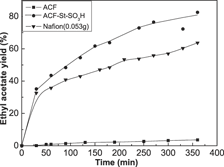Crossref Citations
This article has been cited by the following publications. This list is generated based on data provided by
Crossref.
Poonjarernsilp, Chantamanee
Sano, Noriaki
and
Tamon, Hajime
2014.
Hydrothermally sulfonated single-walled carbon nanohorns for use as solid catalysts in biodiesel production by esterification of palmitic acid.
Applied Catalysis B: Environmental,
Vol. 147,
Issue. ,
p.
726.
Poonjarernsilp, Chantamanee
Sano, Noriaki
and
Tamon, Hajime
2015.
Simultaneous esterification and transesterification for biodiesel synthesis by a catalyst consisting of sulfonated single-walled carbon nanohorn dispersed with Fe/Fe2O3 nanoparticles.
Applied Catalysis A: General,
Vol. 497,
Issue. ,
p.
145.
Masghouni, N.
and
Al‐Haik, M.
2015.
Quasistatic and dynamic mechanical characterization of a woven carbon fiber–zinc oxide nanowires–epoxy composite.
Polymer Composites,
Vol. 36,
Issue. 12,
p.
2184.
Wei, Yizhe
Ling, Xinlong
Zou, Liming
Lai, Dengpan
Lu, Hongwei
and
Xu, Yongjing
2015.
A facile approach toward preparation of sulfonated multi-walled carbon nanotubes and their dispersibility in various solvents.
Colloids and Surfaces A: Physicochemical and Engineering Aspects,
Vol. 482,
Issue. ,
p.
507.
Shukla, Avanish
Bhat, Santoshkumar D.
and
Pillai, Vijayamohanan K.
2016.
Simultaneous unzipping and sulfonation of multi-walled carbon nanotubes to sulfonated graphene nanoribbons for nanocomposite membranes in polymer electrolyte fuel cells.
Journal of Membrane Science,
Vol. 520,
Issue. ,
p.
657.
Diyuk, Vitaliy E.
Mariychuk, Ruslan T.
and
Lisnyak, Vladyslav V.
2016.
Functionalization of activated carbon surface with sulfonated styrene as a facile route for solid acids preparation.
Materials Chemistry and Physics,
Vol. 184,
Issue. ,
p.
138.
Yue, Z.
and
Economy, J.
2017.
Activated Carbon Fiber and Textiles.
p.
61.
Bora, Akash Pratim
Dhawane, Sumit H.
Anupam, Kumar
and
Halder, Gopinath
2018.
Biodiesel synthesis from Mesua ferrea oil using waste shell derived carbon catalyst.
Renewable Energy,
Vol. 121,
Issue. ,
p.
195.
Grishchenko, Liudmyla
Bezugla, Tetiana
Zaderko, Alexander
Vakaliuk, Anna
Mischanchuk , Oleksandr
Novychenko, Natalia
Cheremenko , Anastasiia
and
Diyuk, Vitaliy
2019.
CATALYSTS OF ACID-BASE PROCESS ON THE BASIS OF THE MODIFIED CARBON FIBER.
Ukrainian Chemistry Journal,
Vol. 85,
Issue. 7,
p.
38.
Grishchenko, L.M.
Chernenko, S.I.
Vakaliuk, A.V.
Bezugla, T.M.
Tsapyuk, G.G.
Yatsymyrskyi, A.V.
Diyuk, V.E.
Boldyrieva, O.Yu.
Lisnyak, V.V.
Mariychuk, R.
and
Mischanchuk, O. V.
2020.
Oxidation of Sulfurated Polyacrylonitrile-derived Nanostructured Activated Carbon Fibers for Thermal Resistant and Multifunctional Solid Acids.
p.
01TFC07-1.
Ibrahim, Naeemah A.
Rashid, Umer
Choong, Thomas Shean Yaw
and
Nehdi, Imededdine Arbi
2020.
Synthesis of nanomagnetic sulphonated impregnated Ni/Mn/Na2SiO3 as catalyst for esterification of palm fatty acid distillate.
RSC Advances,
Vol. 10,
Issue. 10,
p.
6098.
Grishchenko, Liudmyla M.
Diyuk, Vitaliy E.
Mariychuk, Ruslan T.
Vakaliuk, Anna V.
Radkevich, Valentina Z.
Khaminets, Siarhei G.
Mischanchuk, Oleksandr V.
and
Lisnyak, Vladyslav V.
2020.
Surface reactivity of nanoporous carbons: preparation and physicochemical characterization of sulfonated activated carbon fibers.
Applied Nanoscience,
Vol. 10,
Issue. 8,
p.
2923.
Pandian, Sivakumar
Sakthi Saravanan, Arumugamurthi
Sivanandi, Periyasamy
Santra, Mahula
and
Booramurthy, Vijaya Kumar
2020.
Refining Biomass Residues for Sustainable Energy and Bioproducts.
p.
87.
Diyuk, V. E.
Grishchenko, L. M.
Zaderko, A. N.
Tsapyuk, G. G.
Mischanchuk, O. V.
Boldyrieva, O. Yu.
and
Yatsymyrskyi, A. V.
2021.
Nanomaterials and Nanocomposites, Nanostructure Surfaces, and Their Applications.
Vol. 263,
Issue. ,
p.
385.
Wang, Siyu
Xue, Yuan
Zhao, Xueling
and
Yuan, Hong
2021.
Preparation of a carbon microsphere–based solid acid application to waste frying oil transesterification.
Diamond and Related Materials,
Vol. 116,
Issue. ,
p.
108420.
Grishchenko, L.M.
Zaderko, A.N.
Tsapyuk, G.G.
IMatushko, I.P.
Yatsymyrskyi, A.V.
and
Mischanchuk, O.V.
2021.
Dehydration of isopropyl alcohol with activated carbon functionalized with Br- and S-containing reagents.
Voprosy Khimii i Khimicheskoi Tekhnologii,
p.
90.
Satayeva, A
Kerim, T
Kamal, A
Issayev, J
Inglezakis, V
Kim, J
and
Arkhangelsky, E
2022.
Determination of aspirin in municipal wastewaters of Nur-Sultan City, Kazakhstan.
IOP Conference Series: Earth and Environmental Science,
Vol. 1123,
Issue. 1,
p.
012067.
Grishchenko, L.M.
Vakaliuk, A.V.
Tsapyuk, G.G.
Matusko, I.P.
Kuryliuk, V.V.
Mischanchuk, О.V.
and
Lisnyak, V.V.
2022.
Catalysts for dehydration of isopropyl alcohol based on chlorinated carbon fiber.
Voprosy Khimii i Khimicheskoi Tekhnologii,
p.
3.
García-Alcalde, Laura
González, Zoraida
Concheso, Alejandro
Blanco, Clara
and
Santamaría, Ricardo
2022.
Impact of electrochemical cells configuration on a reliable assessment of active electrode materials for Vanadium Redox Flow Batteries.
Electrochimica Acta,
Vol. 432,
Issue. ,
p.
141225.
Panchal, Balaji
Sun, Yuzhuang
Zhao, Cunliang
Wang, Jinxi
Bian, Kai
Zhao, Qiaojing
and
Liu, Bangjun
2024.
Waste to value addition: Utilization of waste corn cob from corn plant derived novel green acidic catalyst for effective synthesis of esters.
Energy Reports,
Vol. 11,
Issue. ,
p.
4277.


